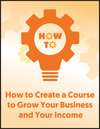The Simple Drilling Down Process that Makes Your Copy Feel More Real and Compelling (and Gets the Kind of Response Your Client Needs)

He loved music and carpentry. But Maurits had trouble with almost all other school subjects (except for math!).
In fact, he failed his final school exam.
And he was devastated.
To console himself, Maurits spent the next few days in his room drawing a sunflower and then turning it into a linocut. If you're not familiar with the term, it's a drawing that's cut onto a linoleum surface using a sharp knife.
It's a tedious and delicate process but one that makes the drawing appear to have different dimensions.
And the man who perfected this type of art was Maurits Cornelis Escher, born in the Netherlands in 1898.
By the time he was 36 years old, he won his first American exhibition prize. He was quickly gaining fame for his etchings, drawings, and linocuts that seemed as if they weren't really done on flat surfaces.
But that's what Maurits liked to do … create the illusion of three-dimensions.
His most famous sketch is Drawing Hands, which is of two hands, each drawing the other with a pencil.
Maurits was a master of using shading, lines, and tones to make his drawings feel real.
In the world of copywriting, we have our own master of making a product or service feel real to the reader … the legendary Clayton Makepeace.
Clayton, who passed away in April of 2020, was often referred to as the "million-dollar copywriter" because he consistently wrote successful promotions that earned him over $1 million a year in fees and royalties.
Besides creating attention-getting headlines, compelling leads, body copy overflowing with proof, and irresistible offers, Clayton was a genius at "dimensionalizing" benefits.
I'm not sure if Clayton coined the phrase, but he certainly knew how to use it in copy …
When you "dimensionalize" a benefit in your copy, what you're really doing is making it as compelling as possible to your reader.
Similar to how Maurits used shading to give his drawings a 3-D effect, in copy, you add dimension by painting word pictures of all the ways the prospect will enjoy that benefit.
Then you compare that benefit with those offered by others. You add specifics that demonstrate all the ways the benefit will enrich the prospect's life.
Here are a few examples from Clayton on how adding dimension improves your copy:
Dimension Benefit Example #1: You're selling something made of steel …
- Feature: Constructed of carbon steel.
- Why: Never wears out.
- Benefit: The last drill bit you'll ever buy.
- Dimensionalized Benefit: You can save up to $75 a year in broken drill bits … hours of unnecessary trips to the hardware store … and hundreds of dollars in lost income!
Dimension Benefit Example #2: A dentist looking to attract new patients …
- Feature: A TV in every exam room.
- Why: More comfortable for the patient and time passes more quickly.
- Benefit: Your appointment is over before you know it!
- Dimensionalized benefit: Great for fidgety kids: The time zips by. In fact, just last week, little Jimmy asked if he could stay longer.
Dimension Benefit Example #3: An investment newsletter attempting to increase its subscription base …
- Feature: Daily e-zine included with subscription to monthly newsletter.
- Why: Stocks move fast; opportunities could be lost without constant updates.
- Benefit: You'll never get caught wondering what to do when major events break!
- Dimensionalize: You'll lock in your profits when the market sags and go for even greater profit potential by getting into each up-move on the ground floor.
Dimension Benefit Example #4: You're creating your own line of information products, in this case an e-book on health …
- Feature: Specific prescription for each age group on each supplement recommended.
- Why: To eliminate reader confusion.
- Benefit: You'll always know precisely what you should be taking … how much you should be taking … and even when to take it.
- Dimensionalize: You'll know what is best for your lifestyle so you'll never over or under medicate. You'll know how to achieve the best balance for your system so your body is always at peak performance. You'll prevent any medical issues that hamper people and keep them from living their best life.
Basically, what you're doing here, is drilling down to the next-level benefit.
You're constantly asking what is the benefit of the benefit. AND what is the benefit of that benefit. And what is the benefit of THAT benefit!
Each time you do this, you're adding another dimension to your benefit. And that is when the product or service you're selling starts to feel real to your reader.
The more real it is, the higher the chances your reader is going to want what you are selling. That means they're hitting the buy button more often. And of course, when that happens, your client is happy because more sales are coming in.
And you're happy because you're making more money and adding another winning promotion to your portfolio of services.

The Course Creator’s Playbook: A Step-by-Step Guide to Building and Selling Courses People Want
If you’ve ever solved a problem for yourself, have experience at a career or job, or have a passion or hobby you do for fun … you have knowledge people will pay for! Discover how to tap into this massive, nearly $500-million-a-day opportunity … Learn More »
Guest, Add a Comment
Please Note: Your comments will be seen by all visitors.